
Terek Cavalry
Historically most units supplied from the Terek Host were cavalry. This carried over into the Civil War period, although a shortage of horses meant more men fought on foot.
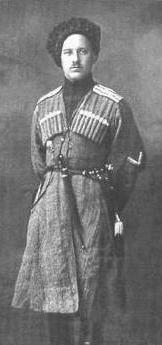
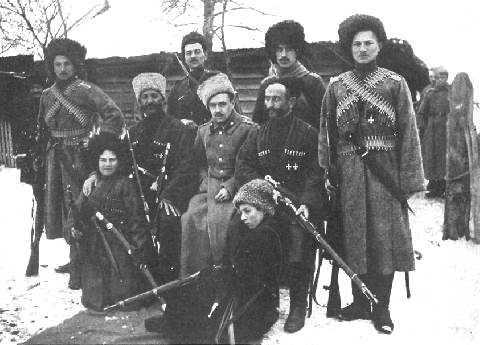
On the left, a typical Terek officer of the RCW period in a studio shot. Note the AFSR chevron on his left arm: while part of the official uniform, they are rarely seen on cherkeskas. To the right a shot of a Terek group supoosedly taken in 1919.
1st and 2nd Volga Regiments
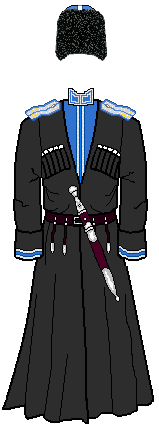 |
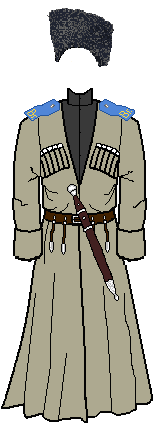 |
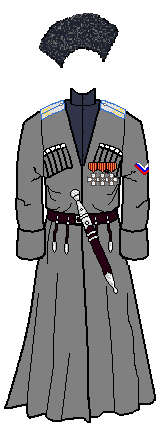 |
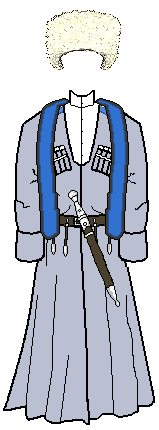 |
| Officer: official uniform | Trooper: wartime dress | Officer: field dress | Trooper: with bashlyk |
Officially it seems that the beshmet undershirt was be pale blue trimmed with lace along the collar and front. In the field plain shirts were very much the norm.
Uniform Details
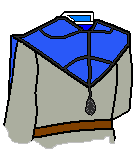 |
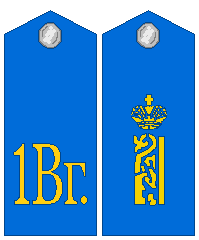 |
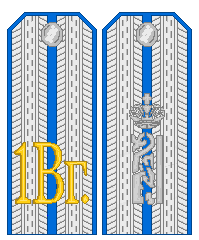 |
 |
|---|---|---|---|
| Terek bashlyk: blue, with black trim. (Not all were piped.) | Shoulderboards of 1st Volga Regiment: Trooper up to 1916 and then with new monogram | Shoulderboards of 1st Volga Regiment: Esau (Captain) up to 1916 and then with new monogram | Terek papakha: cross for officers and plain for men |
Buttons and officer lace were silver, and as cavalry units that meant that officer markings were normally in gold.
An exception to this rule was that in 1916 the 1st Volga Regiment were granted the monogram A of the Tsarevich (shown) which was in silver for officers. Likewise the 1st Kizlyar-Grebensk Regiment was granted the monogram N of the Tsar in 1915, so that also would be an exception in silver. These two regiments probably reverted back to their original gold letter ciphers in 1917 with the abdication.
The field versions of the shoulderboards for rankers were the same, but khaki with the unit number and cipher (or monogram) stenciled on in dark blue.
Ciphers were Вг for the Volga Regiments; Г-М for the Mountain-Mozdok Regiments; К-Г for the Kizlyar-Grebenski Regiments; and С-В for the Sunzhensk-Vlaikavkaz Regiments. In peacetime only one regiment of each area was formed, so there was no need for a leading number, but during WWI and the RCW there were multiples of each and so the appropriate number was added.
Terek Cossacks never seem to have work standard military furazhka peaked caps. Crowns of fur hats might be coloured as shown, or plain khaki in the field. Few men seem to have worn cockades.
Mamontov also speaks of "the first regiment of the Terek" exchanging their papakhi for broad-brimmed felt hats in good weather, so that they looked like Mexican cow-boys.
History in the RCW
A unit called the 1st Volga Regiment formed in July 1918 as part of the 1st Cossack Horse Division, part of Colonel Shkuro's detached force operating in the Caucasus. In October 1918 the unit entered the Volunteer Army and was broken up (the men were placed in the 2nd Kuban Cossack Division).
Meanwhile two units claiming descent from the old Imperial 1st and 2nd Volga Regiments (and probably including men from them) had been formed in September 1918 as part of the Volunteer Army. They were in the 1st Caucasian Cossack Division until January 1919, when they entered the 1st Terek Cossack Division.
In October 1919 the 1st Terek Cossack Division, now composed of the two Volga Regiments and the 1st and 2nd Mountain-Mozdok Regiments, was fighting with the Army of the Don. Attached with them in the division was a rifle regiment and an artillery divizion of 3 horse batteries. The 1st Volga Regiment numbered some 625 sabres and 35 MGs (tachanki) at this time.
The 1st Volga regiment was commanded from March 1919 by Colonel V.I. Staritskii. The 2nd Volga Regiment was commanded by Lt-Colonel Menyakov.
The units of the division broke up in mid-1920, after the disastrous retreat. A 1st Terek Cossack Regiment was formed around the remaining parts in Wrangel's "Russian Army", as part of the Terek-Astrakhan Brigade.
Flags
As former Imperial Army units the regiments may have preserved their old Imperial banners, and may have carried them with their HQs in the field. All four Volga Regiments had 1857 models that would have looked more or less like this:
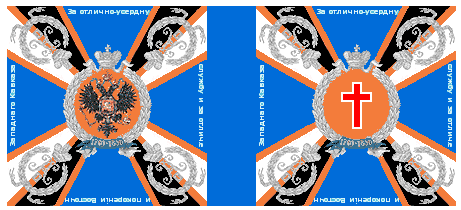
The field banner of the regimental commander was in the Host colour with a distinguishing number in yellow. That's pretty boring, so I have included some other options based on the blue and black diagonal flag of the independent Terek republic.
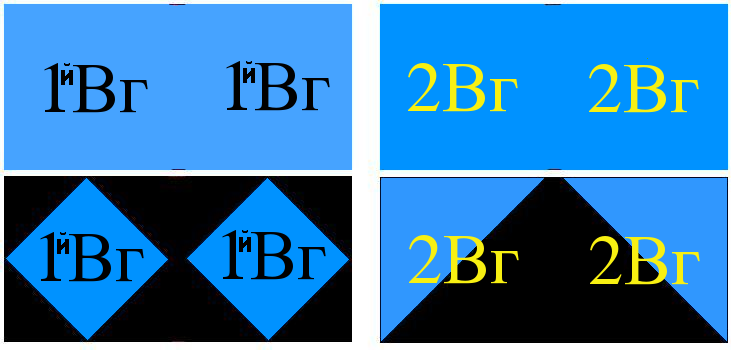
Sotnia (i.e. squadron) flags were Host colour above and squadron colours below (namely in order: scarlet, light blue, white, dark green, yellow and brown).

Other Similar Units
Figures painted in these uniforms would be similar to any Terek units of WWI or the Civil War, with just the cipher distinguishing them.
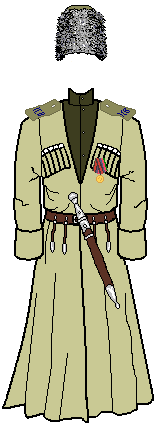 |
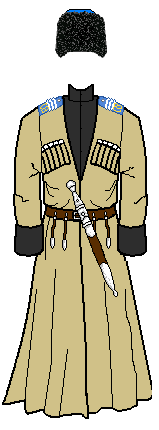 |
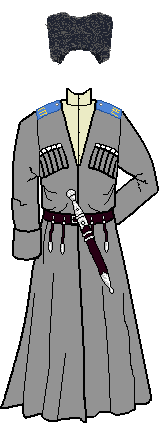 |
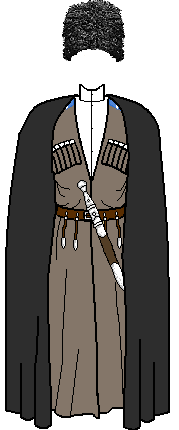 |
| Trooper: 1st Sunzhensk-Vladikavkaz | NCO: Sunzhensk-Vladikavkaz | Trooper: Mountain-Mozdok Regt | Trooper: field dress with burka |
Units painted as Terek Cossacks are extremely versatile, because while most Terek units fought on the right flank of the AFSR – in the Forces of the North Caucasus around Tsaritsyn and Astrakhan – units were also loaned to the Don Army and sometimes to the Volunteer Army. For late 1920 they could represent the 1st Terek Cossack Regiment in the Crimean breakout.
The Terek uniform is also very similar to that of the Ossetian units of the AFSR, some of whom also fought with Volunteer Army in the Ukraine.
Photos
We have collected a number of photos of Terek Cossacks, although most date from before the Civil War unfortunately, on a separate page.